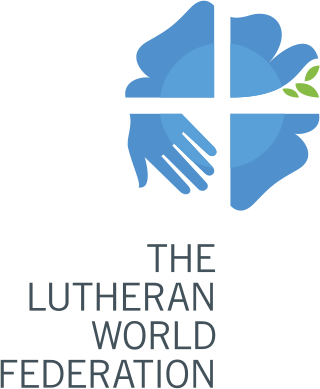
The Lutheran World Federation is a global communion of national and regional Lutheran denominations headquartered in the Ecumenical Centre in Geneva, Switzerland. The federation was founded in the Swedish city of Lund in the aftermath of the Second World War in 1947 to coordinate the activities of the many differing Lutheran churches. Since 1984, the member churches are in pulpit and altar fellowship, with common doctrine as the basis of membership and mission activity.
Hermannsburg is a village and a former municipality in the Celle district, in Lower Saxony, Germany. Since 1 January 2015 it is part of the municipality Südheide. It has been a state-recognised resort town since 1971. It is situated on the river Örtze, about 15 kilometres east of Bergen and 30 kilometres north of Celle. It belongs to the district of Celle.

Hermannsburg, also known as Ntaria, is an Aboriginal community in Ljirapinta Ward of the MacDonnell Shire in the Northern Territory of Australia, 125 kilometres (78 mi); west southwest of Alice Springs, on the Finke River, in the traditional lands of the Western Arrarnta people.
Greytown is a town situated on the banks of a tributary of the uMvoti River in a richly fertile timber-producing area of KwaZulu-Natal, South Africa.
New Germany is an industrial town situated just inland from Durban in KwaZulu-Natal, South Africa. It has been incorporated firstly into Pinetown and now into eThekwini. Originally Neu-Deutschland and subsequently translated, the name refers to settlement of the area by German immigrants in 1848. They came over to farm cotton, but when that crop proved unsuccessful, the settlers turned to growing vegetables and flowers. The town became a municipality in 1960.

Kroondal is a village situated in North West Province of South Africa with a large German speaking community. It lies on the N4 road.

The Hermannsburg Mission was founded as the Hermannsburg Mission Centre in 1849 in Hermannsburg, near Celle, North Germany, by Louis Harms. In 1977, the independent mission society was merged into the work of the Evangelical-Lutheran Mission in Lower Saxony. As a result, it became an institution recognised by the state church.
The United Congregational Church of Southern Africa (UCCSA) is a prominent Christian denomination established in 1967, following the unification of various congregational movements within Southern Africa. Its origins can be traced back to the missionary work of the London Missionary Society in the Cape Colony in 1799. The UCCSA plays a significant role in the religious landscape of Southern Africa, with a membership of approximately 500,000. It maintains a notable presence in countries such as South Africa, Mozambique, Botswana, Zimbabwe, and Namibia. The UCCSA is recognized for its contributions to education and social justice in the region.
The Berlin Missionary Society (BMS) or Society for the Advancement of evangelistic Missions amongst the Heathen was a German Protestant (Lutheran) Christian missionary society that was constituted on 29 February 1824 by a group of pious laymen from the Prussian nobility.
The Hermannsburg Mission House is a provincial heritage site in Hermannsburg, Umvoti District, in the province of KwaZulu-Natal in South Africa. It is owned and operated by the Hermannsburg School.

The Evangelical-Lutheran Mission in Lower Saxony or ELM is a German Protestant mission organisation.
Hermannsburg is a municipality in Lower Saxony, Germany.
The Hermannsburg Mission Seminary is a seminary in Hermannsburg, Germany. It is part of the Evangelical-Lutheran Mission in Lower Saxony (ELM), the common missionary work of the state churches of Hanover, Brunswick and Schaumburg-Lippe.

Georg Ludwig Detlef Theodor Harms (1808–1865) was a German Lutheran pastor who was nicknamed the "Reviver of the Heath". One of the most significant Christian revivalists of the 19th century, he turned the little village of Hermannsburg on the Lüneburg Heath into the most important centre of revival in Lower Saxony.

Daniel Lindley was an American missionary in South Africa. He and his wife Lucy founded the Inanda Seminary School in 1869. Lindley was pastor to the first Dutch Reformed Church in the Orange Free State. He was a pastor to the Voortrekkers.

Lüneburg is a farming community in eDumbe Local Municipality in the KwaZulu-Natal province of South Africa.
Hermannsburg School, originally Deutsche Schule Hermannsburg, is a private school in Hermannsburg, KwaZulu-Natal, South Africa.
Johann Heinrich Christoph Johannes was born on 16 August 1852 in the Lower Saxony state, Germany and died on 13 September 1943, in the Eastern Transvaal South Africa He was a missionary in eNyathi, Colony of Natal, South Africa.
Otto Heinrich Röttcher was a missionary, established a town in South Africa and is known for making “wine“ out of oranges. He came from Müden (Aller), Germany to South Africa.

Izotsha is a small rural settlement on the South Coast of the KwaZulu-Natal province of South Africa, just inland from Shelly Beach and approximately 7 kilometres south-west of Port Shepstone. The name ‘Izotsha’ translates to 'it will burn’ in the Zulu language.











